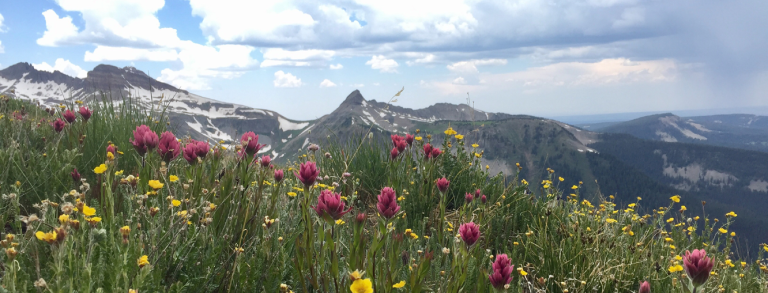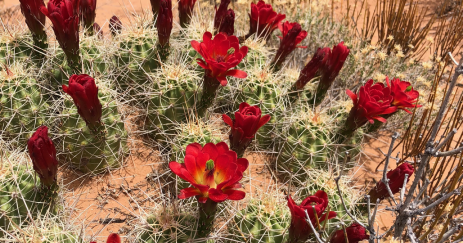OUR 2021 CONFERENCE will bring us to Durango, Colorado, my hometown near the very southwestern corner of the state at the edge of the mighty San Juan Range of the Rockies and the high desert plateaus of Utah, New Mexico, and Arizona. My own route here was a circuitous one from the U.S. South to northern Europe, to the western U.S. to the northeastern U.S. and back again to the Rockies. Durango combines a few parts of all of my favorite places though, of course, its seas are long gone and have left very different impressions in the landscape.
All along the way I have gathered memories of favorite iconic plants associated with each of these places and times of my life. And in each, one or a few very special people have served as mentors in my horticultural education. East Texas, Tennessee, and western New York have served as inspiration in my study of woody plants, especially trees; and the rest are all iconic places of edges: wide open skies, mountains or the sea, and their associated plants and people.
Horticulture in northeast Texas in the sixties was what I might describe as genteel and prescriptive, mostly run by garden clubs and plant societies and sanitized with an entire army’s worth of chemical stockpiles. I was most often somewhere in the crown of a beautiful old live oak (Quercus virginiana). Dallas was a stronghold and outpost for them and giant old southern magnolias (Magnolia grandiflora), too. Ice storms took a toll, but the trees that weathered them were all the more admirable. An old live oak is one of the tree kingdom’s most venerable and handsome monarchs.
My college days at the University of the South in Tennessee were all spent in the embrace of The Domain, a ten-thousand-acre forest and one of North America’s jewels at the southern end of the Cumberland Plateau. It is an amazingly diverse upland temperate mixed forest of northern and southern plants. Luckily, the university has one of the country’s best schools of forestry and their courses were like catnip for a tree lover like me. I was ostensibly studying English literature there, but forestry was my secret indulgence and passion. It was here that I was able to appreciate the magnificence of our native deciduous magnolias, but it was the American beeches that really captivated me. Their sinewy muscular trunks and perfect papery leaves at all seasons are unforgettable, as is the magical light and understory that only a beech wood can display.
Northern Europe, where I lived for eleven years, was the next station on my horticultural pilgrimage and became the foundation of my life as a nurseryman. Not only was I able to learn the trade from the ground up, but I was also able to apprentice in many different nurseries and botanic gardens (including a summer internship at the Royal Botanic Gardens, Kew). The climate has left a shared flora that makes one instantly at home in any of the related countries. It was here that I came to appreciate rock gardening practiced on a high level. I joined the American Rock Garden Society, the Danish chapter of the American Rhododendron Society, and the Danish Dendrological Society. All of them had an international membership with an incredible collective knowledge of their own plants. I, of course, met our American beech’s European relative. Beech in Denmark is as close to a living god as anything in this world. It is a touchstone of Danish history and culture. But I especially came to love the wild Erica (and Calluna) in Scandinavia. They are so tied to place and have such a rugged and admirable beauty that one cannot help but be captivated by them.
I spent my last year in Scandinavia in Alnarp, Sweden, where one of the country’s finest horticultural schools teaches graduate students. It is one of the most beautiful, far-reaching, and inspiring places to study. Its libraries and gardens are full of treasures old and new from all over the world. Kenneth Lorentzon, now sadly passed all too soon away, was the best teacher one could ever hope for. His plant knowledge was inexhaustible, his teaching innovative and welcoming, and his human touch and innate sense of humor enhanced everything he did. He was also a natural bond between generations of plantsmen, gardeners, and botanists, and secured the Scandinavian horticultural legacy. His influence at both Alnarp, and especially Gothenburg, is still strong and instantly recognizable.
The plant life at Alnarp must be seen to be believed. Not only are there new treasures among the latest varieties of plants, but they have preserved an amazing collection of trees and shrubs that date back to the 1860s. The world champion Wisteria sinensis is worth traveling for alone. But as it happened, one of my favorite genera, Sorbus, was at the center of several exciting newly introduced plants from Asia. The outstanding tree among them, introduced by the Swedish dendrologist Tor Nitzelius from Ulleung-Do is one of the planet’s most beautiful trees. It now has the name Sorbus ulleungensis. When I was there, the original seedlings were just coming into maturity for evaluation and selection of a worthy clone.
I returned to the U.S. in 1992 and had the great privilege to spend more than a month at the Arnold Arboretum studying the collections of Joseph Rock from Gansu, China. Not only was that an amazing experience, but having the run of one of the worlds’ premier collections of woody plants was a generous bite of heaven. I happened to be back east once more, in Rochester, New York, for just over three years in the late nineties. Rochester has one of North America’s richest and best-documented horticultural legacies. It has four parks designed by F.L. Olmsted some with unique plant introductions of E.H. Wilson, Joseph Rock, Charles Sargent, and others, and still with the substantial donation of trees and shrubs from North America’s original and most brilliant nurserymen, Patrick Barry and George Ellwanger. I cannot name a single plant from that time, they were simply all of them memorable. But Highland Park, in particular, has the lion’s share of them and should be seen by anyone interested in plants.
Lisa, my wife, and I arrived in Durango in 2002 and have enjoyed nearly every day living here since. The scenery, between the San Juans and their outlying ranges and the mountains seen on the horizons of New Mexico, Arizona, and Utah, is incomparable. Not only do we have a large cohort of the southern Rockies’ best alpines, but we also have really interesting endemic plants; and since we transition from the high deserts to the tops of fourteeners (a mountain peak with an elevation of at least 14,000 feet/4,267 m), we have a good share of all their plants as well.
Spring here usually begins sotto voce and, if the sun is smiling, bladderworts start to peek from many a nook and cranny. They are welcome, cheerful, tough little plants that hold their own in our stubborn soils and fickle climate.
We hold an annual tradition in our family to celebrate our spring birthdays by traveling to one of Utah’s most amazing lookouts. It encompasses several geological epochs and some of the state’s best sandstone country, overlooking the famous goosenecks of the San Juan River, the finely sculpted pieces of Monument Valley, and the gateway to central Utah’s famous parks: Capitol Reef, Bryce Canyon, and Zion. At this time of year, we are greeted by the intense fiery dark red chalices of Echinocereus coccineus, and the prolific bloom of Purshia mexicana, as well as many fine penstemons at their peak bloom.
Late spring admits entry to the upper montane and subalpine, depending on the snowpack, and here we find rare glimpses of Erythronium grandiflorum and Aquilegia elegantula, as well as other of our Rocky Mountain alpines. For myself, I admire the delicate soft green of aspens unfolding.
At the very end of spring, and beginning of summer in mid- to late June, we are gifted a magical moment when the whole of southwest Colorado is alive with plants emerging, blooming, and reaching toward ripeness. This is the time of our 2021 Conference. I revel in all of its glory and, as you can tell, I am too eclectic to settle on any one plant during these days. But I know that come next June you will find many favorite ones of your own.


